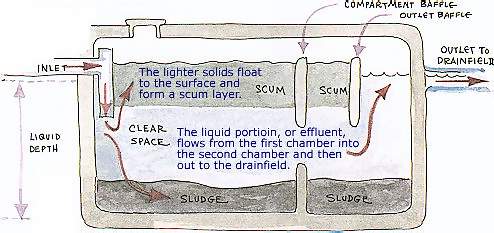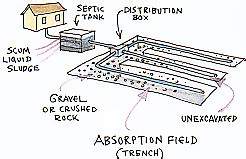|
Septic
Systems
More than
one of four homes in the Puget Sound area rely on septic systems
to treat and dispose of household wastewater. A properly designed,
installed and maintained septic system call provide an efficient
method of wastewater treatment, adequately treating sewage before
it mixes with surface or ground waters. In the last 10 years,
most Puget Sound shellfish harvest restrictions have been in
rural and semi-rural areas served by septic systems. Failures
of these systems are a major contributor to the pollution which
forced the restrictions. As a householder, you need to understand
how to keep your system working well.

How
Your Septic System Works –
Septic
systems have two key components – a SEPTIC
TANK and a SOIL ABSORTION SYSTEM.
The septic tank is a container, usually with two compartments,
fabricated from concrete or plastic.
 Wastewater
from your bathroom, kitchen and laundry room enters the septic
tank through your building sewer. Wastewater
from your bathroom, kitchen and laundry room enters the septic
tank through your building sewer.
Heavy solid
particles settle to the bottom where bacterial action
converts them to a digested sludge.
Settling
and breakdown of solids takes time and your tank must be large
enough for complete digestion to occur.
 The
drainfield is the soil absorption system and consists of a distribution
box, perforated distribution lines made of plastic or tile, and
an area of soil. In the drainfield, disease causing microorganisms
and some suspended solids and nutrients are removed as the liquid
is absorbed by the soil. If the soil cannot absorb the liquid
at the rate at which it enters the septic tank, the plumbing will
“back up” or wastewater will bubble to the surface in the drainfield. The
drainfield is the soil absorption system and consists of a distribution
box, perforated distribution lines made of plastic or tile, and
an area of soil. In the drainfield, disease causing microorganisms
and some suspended solids and nutrients are removed as the liquid
is absorbed by the soil. If the soil cannot absorb the liquid
at the rate at which it enters the septic tank, the plumbing will
“back up” or wastewater will bubble to the surface in the drainfield.
The soil
also needs time to filter out these harmful materials from the
wastewater. “Suitable soils” do not include sand (which permits
wastewater to pass through too fast) or clay (which accepts
only small amounts of wastewater). Siting your septic tank is
a critical decision regulated by local and state health regulations.
Consult your county health department before constructing or
remodeling your septic system.
|



